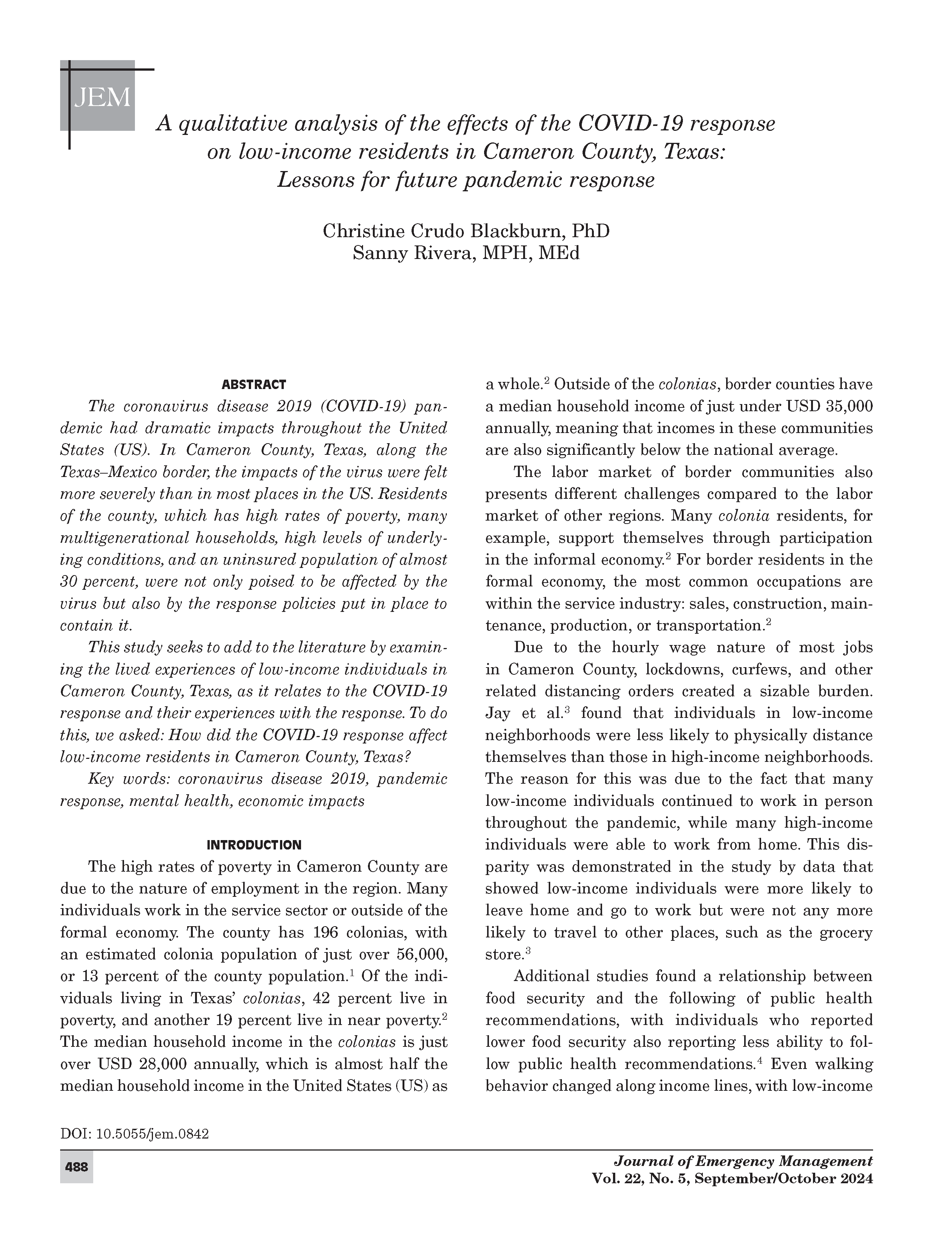A qualitative analysis of the effects of the COVID-19 response on low-income residents in Cameron County, Texas: Lessons for future pandemic response
DOI:
https://doi.org/10.5055/jem.0842Keywords:
coronavirus disease 2019, pandemic response, mental health, economic impactsAbstract
The coronavirus disease 2019 (COVID-19) pandemic had dramatic impacts throughout the United States (US). In Cameron County, Texas, along the Texas–Mexico border, the impacts of the virus were felt more severely than in most places in the US. Residents of the county, which has high rates of poverty, many multigenerational households, high levels of underlying conditions, and an uninsured population of almost 30 percent, were not only poised to be affected by the virus but also by the response policies put in place to contain it.
This study seeks to add to the literature by examining the lived experiences of low-income individuals in Cameron County, Texas, as it relates to the COVID-19 response and their experiences with the response. To do this, we asked: How did the COVID-19 response affect low-income residents in Cameron County, Texas?
References
Texas Department of Housing and Community Affairs: Background on the colonias. n.d. Available at https://www.tdhca.state.tx.us/oci/background.htm. Accessed February 17, 2023.
Federal Reserve Bank of Dallas: Las colonias in the 21st century: Progress along the Texas-Mexico border. 2015. Available at https://www.dallasfed.org/~/media/documents/cd/pubs/lascolonias.pdf. Accessed January 26, 2022.
Jay J, Bor J, Nsoesie EO, et al.: Neighbourhood income and physical distancing during the COVID-19 pandemic in the United States. Nat Hum Behav. 2020; 4: 1294-1302. DOI: https://doi.org/10.1038/s41562-020-00998-2
Wolfson JA, Leung CW: Food insecurity and COVID-19: Disparities in early effects for US adults. Nutrients. 2020; 12(6): 1648. DOI: https://doi.org/10.3390/nu12061648
Hunter RF, Garcia L, Herick de Sa T, et al.: Effects of COVID-19 response policies on walking behavior in US cities. Nat Commun. 2021; 12: 3642. DOI: https://doi.org/10.1038/s41467-021-23937-9
Vasileiou K, Barnett J, Thorpe S, et al.: Characterising and justifying sample size sufficiency in interview-based studies: Systematic analysis of qualitative health research over a 15-year period. BMC Med Res Methodol. 2018; 18(148). DOI: 10.1186/s12874-018-0594-7. DOI: https://doi.org/10.1186/s12874-018-0594-7
Braun V, Clarke V: Using thematic analysis in psychology. Qual Res Psychol. 2006; 3(2): 77-101. DOI: https://doi.org/10.1191/1478088706qp063oa
Coelho CM, Suttiwan P, Arato N, et al.: On the nature of fear and anxiety triggered by COVID-19. Front Psychol. 2020; 11: 581314. DOI: https://doi.org/10.3389/fpsyg.2020.581314
Kowalczuk I, Gębski J: Impact of fear of contracting COVID-19 and complying with the rules of isolation on nutritional behaviors of Polish adults. Int J Environ Res Public Health. 2021; 18(4): 1631. DOI: https://doi.org/10.3390/ijerph18041631
Rodriguez S, Valle A, Pineiro I, et al.: COVID-19 lockdown: Key factors in citizens’ stress. Front Psychol. 2021; 12(666891): 1-9. DOI: https://doi.org/10.3389/fpsyg.2021.666891
Kirmayer LJ, Narasiah L, Munoz M, et al.: Common mental health problems in immigrants and refugees: General approach in primary care. Can Med Assoc J. 2011; 183(12): E959-E967. DOI: https://doi.org/10.1503/cmaj.090292
Sieffien W, Law S, Andermann L: Immigrant and refugee mental health during the COVID-19 pandemic: Additional key considerations Canadian family physician. 2020. Available at https://www.cfp.ca/news/2020/06/23/06-23-1a. Accessed December 12, 2021.
US Bureau of Labor Statistics: Economy at a glance—Brownsville-Harlingen, TX. n.d. Available at https://www.bls.gov/eag/eag.tx_brownsville_msa.htm. Accessed October 20, 2021.
Novak A, Ferman M, Cai M: How coronavirus impacted the Texas economy. June 26, 2021. The Texas Tribune. Available at https://apps.texastribune.org/features/2020/texas-unemployment/. Accessed October 15, 2021.
Scarpetta S, Dumont JC, Liebig T: What is the impact of the COVID-19 pandemic on immigrants and their children? OECD. 2020. Available at https://read.oecd-ilibrary.org/view/?ref=137_137245-8saheqv0k3&title=what-is-the-impact-ofthe-COVID-19-pandemic-on-immigrants-and-their-children%3F&_ga=2.253562378.2006201921.1635967769-7820437.1635967769. OECD (oecd-ilibrary.org). Accessed December 12, 2021.
US Bureau of Labor Statistics: Unemployment rate in Cameron county, TX. n.d. Available at https://fred.stlouisfed.org/series/TXCAME2URN. Accessed October 5, 2021.
Migration Policy Institute: Profile of the unauthorized population: Cameron county, TX. Available at https://www.migrationpolicy.org/data/unauthorized-immigrant-population/county/48061. Accessed October 1, 2021.
Smith R: Immigrant workers’ eligibility for unemployment insurance. 2020. National Employment Law Project. Available at https://www.nelp.org/publication/immigrant-workers-eligibilityunemployment-insurance/. Accessed November 2, 2021.
Li K, Foutz NZ, Cai Y, et al.: Impacts of COVID-19 lockdowns and stimulus payments on low-income population’s spending in the United States. PLoS One. 2021; 16(9): e0256407. DOI: 10.1371/journal.pone.0256407. DOI: https://doi.org/10.1371/journal.pone.0256407
Chen CY, Byren E, Velez T: Impact of the 2020 pandemic of COVID-19 on families with school-aged children in the United States: Roles of income level and race. J Family Issues. 2022; 43(3): 719-740. DOI: 10.1177/0192513X21994153. DOI: https://doi.org/10.1177/0192513X21994153
Hall LR, Sanchez K, de Garca B, et al.: Income differences and COVID-19: Impact on daily life and mental health. Popul Health Manag. 2022; 25(3): 384-391. DOI: 10.1089/pop.2021.0214. DOI: https://doi.org/10.1089/pop.2021.0214

Published
How to Cite
Issue
Section
License
Copyright 2007-2025, Weston Medical Publishing, LLC and Journal of Emergency Management. All Rights Reserved.





